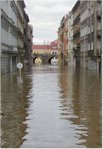Flood
 In western countries, rivers prone to flooding are often carefully managed. Defences such as levees, bunds, reservoirs, and weirs are used to prevent rivers from bursting their banks. Coastal flooding has been addressed in Europe with coastal defenses, such as sea walls and beach nourishment. London is protected from flooding by a huge mechanical barrier across the River Thames, which is raised when the water level reaches a certain point (see Thames Barrier). Venice has a similar arrangement, although it is already unable to cope with very high tides, and will become increasingly inadequate if anticipated rises in sea level occur. The biggest and most elaborate flood defences can be found in the Netherlands, where they are referred to as Delta Works with the Oosterscheldedam as its crowning achievement. These works were build in response to the North Sea flood of 1953 of the south western part of the Netherlands. The Dutch had already build one of worlds largest dams in the north: the Afsluitdijk in response to a flooding in 1916. In some flood-prone areas with high population density, such as parts of the Netherlands, England, and New Orleans and Mississippi River Delta. planning laws have been used to prevent building on flood plains. In some cases, pressure from developers has caused these controls to be eroded, with an increasing number of new developments reliant on artificial defences for protection from floodwaters. Bangladesh has not experienced catastrophic coastal flooding since 1995, but the country relies heavily on foreign support and technology to combat flooding. The United States has donated hurricane shelters to the country, and India provides the Bangladesh government with weather forecasting to give the country time to plan its response to hurricanes. Over the years small cults have formed called "Flood Patrol". These are groups of mostly young men out on the rural roads searching for the next flooded ditch or creek to drive through. Although not very safe, these few brave individuals risk their well being to bring you some of the best pictures of floods available.
In western countries, rivers prone to flooding are often carefully managed. Defences such as levees, bunds, reservoirs, and weirs are used to prevent rivers from bursting their banks. Coastal flooding has been addressed in Europe with coastal defenses, such as sea walls and beach nourishment. London is protected from flooding by a huge mechanical barrier across the River Thames, which is raised when the water level reaches a certain point (see Thames Barrier). Venice has a similar arrangement, although it is already unable to cope with very high tides, and will become increasingly inadequate if anticipated rises in sea level occur. The biggest and most elaborate flood defences can be found in the Netherlands, where they are referred to as Delta Works with the Oosterscheldedam as its crowning achievement. These works were build in response to the North Sea flood of 1953 of the south western part of the Netherlands. The Dutch had already build one of worlds largest dams in the north: the Afsluitdijk in response to a flooding in 1916. In some flood-prone areas with high population density, such as parts of the Netherlands, England, and New Orleans and Mississippi River Delta. planning laws have been used to prevent building on flood plains. In some cases, pressure from developers has caused these controls to be eroded, with an increasing number of new developments reliant on artificial defences for protection from floodwaters. Bangladesh has not experienced catastrophic coastal flooding since 1995, but the country relies heavily on foreign support and technology to combat flooding. The United States has donated hurricane shelters to the country, and India provides the Bangladesh government with weather forecasting to give the country time to plan its response to hurricanes. Over the years small cults have formed called "Flood Patrol". These are groups of mostly young men out on the rural roads searching for the next flooded ditch or creek to drive through. Although not very safe, these few brave individuals risk their well being to bring you some of the best pictures of floods available.
Easter
 In the Czech Republic and Slovakia, a tradition of whipping is carried out on Easter Monday. In the morning, males whip females with a special handmade whip called pomlázka (in Czech) or korbáč (in Slovak). The pomlázka/korbáč consists of eight, twelve or even twenty-four withies (willow rods) and is usually from half a meter to two meters long and decorated with coloured ribbons at the end. It must be mentioned that while whipping can be painful, the purpose is not to cause suffering. Rather, the purpose is for males to exhibit their attraction to females; unvisited females can even feel offended. The whipped female gives a coloured egg to the male as a sign of her thanks and forgiveness. A legend says that females should be whipped in order to keep their health and fertility during whole next year. In some regions the females can get revenge in the afternoon when they can pour a bucket of cold water on any male. The habit slightly varies across the Czech Republic. A similar tradition existed in Poland (where it is called Dyngus Day), but it is now little more than an all-day waterfight.
In the Czech Republic and Slovakia, a tradition of whipping is carried out on Easter Monday. In the morning, males whip females with a special handmade whip called pomlázka (in Czech) or korbáč (in Slovak). The pomlázka/korbáč consists of eight, twelve or even twenty-four withies (willow rods) and is usually from half a meter to two meters long and decorated with coloured ribbons at the end. It must be mentioned that while whipping can be painful, the purpose is not to cause suffering. Rather, the purpose is for males to exhibit their attraction to females; unvisited females can even feel offended. The whipped female gives a coloured egg to the male as a sign of her thanks and forgiveness. A legend says that females should be whipped in order to keep their health and fertility during whole next year. In some regions the females can get revenge in the afternoon when they can pour a bucket of cold water on any male. The habit slightly varies across the Czech Republic. A similar tradition existed in Poland (where it is called Dyngus Day), but it is now little more than an all-day waterfight.
In Hungary (where it is called Ducking Monday), perfume or perfumed water is often sprinkled in exchange for an Easter egg.In the United States and Canada, the Easter holiday has been partially secularized, so that some North American families participate only in the attendant revelry, central to which is decorating Easter eggs on Saturday evening and hunting for them Sunday morning, by which time they have been mysteriously hidden all over the house and garden. According to the children's stories, the eggs were hidden overnight and other treats delivered by the Easter Bunny in an Easter basket which children find waiting for them when they wake up. The Easter Bunny's motives for doing this are seldom clarified. Many families in North America will attend Sunday Mass in the morning and then participate in a feast or party in the afternoon.In Norway, in addition to skiing in the mountains and painting eggs for decorating, it is tradition to solve murders at Easter. All the major television channels show crime and detective stories (such as Poirot), magazines print stories where the readers can try to figure out who did it, and many new books are published. Even the milk cartons change to have murder stories on their sides. Another tradition is Yahtzee games.


